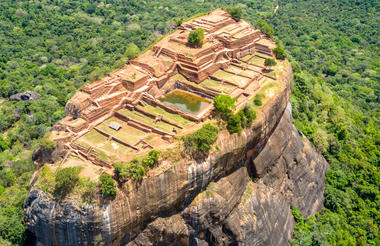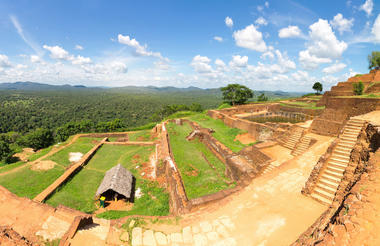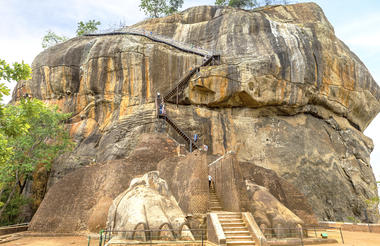Check in at Heathrow two -three hours prior to departure for your overnight flight (non stop) to Colombo.
On arrival at Colombo airport you will be met and transferred to your first stop in the Cultural Triangle. Your driver guide will remain with you except at the beach.



Anuradhapura (by bike) was the first capital and undoubtedly the grandest city of the ancient Sri Lanka, It is the home of two World Heritage sites. Many places of historical and archaeological interest are found here. However, given the one and half to two hour journey to reach Anuradhapura from most of the hotels in the Sigiriya district and the scale of the ancient city, we recommend a full day is allocated to this attraction and visitors who are restricted on time normally chose not to visit Anuradhapura. Sri Maha Bodhi, the sacred bo-tree, was brought as a sapling of the tree under which prince Siddhartha attained to enlightenment and it is over 2,300 years old and is said to be the oldest historically documented tree in the world. At Brazen Palace, (2nd century B.C), the 1600 stone columns you see are all that is left of a magnificent multi-storied residence for monks. Ruwanweliseya (2nd century B.C) is the most famous of all the Dagobas.
It originally depicted the perfect 'bubble shape' that modern restoration has not been able to accurately reproduce. The Samadhi' Buddha statue (4th century AD) is one of the most famous statues, depicting the Buddha in a state of 'Samadhi' or deep meditation. Isurumuniya rock temple (3rd century B.C) is well known for its rock carvings of 'The Lovers'. Kuttam Pokuna – twin ponds (6th century AD) was used by the Buddhist monks as a bathing pool. Thuparama Dagoba (3rd century B.C) is the oldest Dagoba in the island, which enshrines the right collarbone of the Buddha. Close by, some 30 minutes by car, in Mihintale, is the site where Buddhism was first introduced to Sri Lanka. Found on this rock are many shrines and dwellings originally used by monks. A grand stairway of 1,840 steps made of 15 feet wide granite slabs leads to the summit from where one can get a splendid view of the surrounding countryside.
Just 30 minutes from Anuradhapura is Mihintale, where Buddhism was first introduced to Sri Lanka. On this rock are many shrines and dwellings originally used by monks. A grand stairway of 1,840 steps made of 15 feet wide granite slabs leads to the summit from where there is a splendid view of the surrounding countryside. With a very spiritual feel, Mihintale is an important place for Sri Lankan Buddhists who make regular pilgrimages to its many temples.



Morning
Afternoon
Mihintale
Jeep safari to Wilpattu National Park
The park is situated along the Northwest coast lowland dry zone of Sri Lanka. It comprises of a unique complex of lakes called Villus, which are natural basins that are filled up with rainwater and are surrounded by open grassy plains set within dense scrub jungle. A multitude of sandy paths wind around the entire park and open up into these large natural lakes. The unspoilt and beautiful Wilpattu National Park is one of the largest and oldest National Parks in Sri Lanka. It is ideal for those wanting to escape the flurry of activity of Yala and instead offers the opportunity for a tranquil, peaceful and undisturbed drive.
The biggest draws in Wilpattu are Leopards and Sloth bears. Alongside these, it is possible to see Asian Elephants, Spotted Deer, Barking Deer, Wild Pig, Asiatic Buffalo and Mugger Crocodiles. Endemic birds include the Ceylon Junglefowl, Brown-capped Babbler, Ceylon Woodshrike and Black-capped Bulbul in riverine habitats. Muntjac or Barking Deer are more easily seen in Wilpattu than any other national park. Butterflies recorded include the Great Eggfly, Great Orange Tip, Glad-eye Bushbrown, Blue Mormon, Common Mormon, Common Rose and Crimson Rose.



Morning
Today you will be traveling to Pasikudah and making some stops enroute. The journey time excluding stops in 31/2 - 4 hours. Once you reach your beach hotel, your guide and vehicle will not be available. You will have the next few days to enjoy the beach, We have included a stop at Sigiriya but if you are mad about elephants, we suggest you include a stop at the Minneriya National Park and watch the largest gathering of elephants in Asia. The cost for this is not included but we would be happy to add it.
Enroute climb Sigiriya Rock Fortress
This is one of the most amazing historical sites of Sri Lanka and a must visit. However, take heed, the climb to the top (about 1200 steps)takes about 1-1/2 hours. Not suitable for those who are unfit or cannot deal with heights. Take a moment to read our expert tips.
Sigiriya (Lion Rock) Referred by locals as the Eighth Wonder of the World this ancient palace and fortress complex has significant archaeological importance and attracts thousands of tourists every year. It is probably the most visited tourist destination of Sri Lanka. Sigiriya rock plateau, formed from magma of an extinct volcano, is 200 meters higher than the surrounding jungles. Its view astonishes the visitors with the unique harmony between the nature and human imagination. The fortress complex includes remnants of a ruined palace, surrounded by an extensive network of fortifications, vast gardens, ponds, canals, alleys and fountains. In the 3th century BC the rocky plateau of Sigiriya served as a monastery. In the second half of the 5th century King Kasyapa decided to construct a royal residence here. After his death Sigiriya again became a Buddhist monastery until the 14th century, when it was abandoned. The main entrance is located in the northern side of the rock. It was designed in the form of a huge stone lion, whose feet have survived up to today but the upper parts of the body were destroyed. The western wall of Sigiriya was almost entirely covered by frescoes, created during the reign of Kasyapa. Eighteen frescoes have survived to this day. The frescoes are depicting nude females and are considered to be either the portraits of Kasyapa’s wives and concubines or priestess performing religious rituals. One of the most striking features of Sigiriya is its Mirror wall.
For those who are not comfortable with heights or have problems climbing we suggest the gardens of Sigiriya which are amongst the oldest landscaped gardens in the world. They are located in the western part of the rock with bridges, fountains, as well as surface and underground water pumps.
Minneriya National Park
The Minneriya Tank was created by King Parakarambahu at the height of Polonnaruwa’s glory as the capital of Sri Lanka. The national park based largely around the huge tank (reservoir) was created rather more recently but serves as an important gathering place for Sri Lanka’s large population of elephants. It is a great place for elephant spotting all year round – though as the dry season makes water scarce between June and September, more and more elephants gather on the shores of Minneriya Tank.
Indeed by late August and September, the awe inspiring site of up to 300 elephants can often be seen, in a phenomenon known as ‘The Gathering’. It is the largest concentration and gathering of Asian elephants that can be seen anywhere in the world. Watching baby elephants playing with each other, bull elephants tussling for dominance and the great matriarchs surveying the scene is not a sight you are likely to forget in a hurry. Aside from the elephant, Minneriya is also home to some 23 other species of mammals: some, like the Deer and Sambur you will see, some like the Leopard and the Sloth Bear will probably prove elusive. The arid dry zone is a paradise for many species of Lizard and you will see them here in all their technical colour brilliance if you look carefully enough, as well as snakes like the Indian Python and the Mugger Crocodile. Above all, of course, are Sri Lanka’s wonderfully varied bird population. Among the 150 or so species, particular favorites of ours you may see in Minneriya include the beautiful painted stork, and various other bird species.



Tips on climbing Sigriya.
Avoid the crowds and humidity and be the first to climb. The time for opening may vary but do try to arrive early and be the first to enter.
Go at your pace and take plenty of water with you. Due to the steepness and the humidity it is a very strenuous climb. The first few stairways are relatively unchallenging. The fountain gardens and the Boulder gardens but don't spend too long here. They are worth a visit and you can visit after your climb down but you must stay ahead of the crowds.
The first stop is the mirror wall accessed via and the mirror stair case. The next point of interest is the frescoes. You may be tempted to skip this but don't! The narrow steep staircase is worth climbing. You won't be disappointed.
Keep going. The summit at the top where the palace was located and the views are spectacular.
Avoid the monkeys and the hornets, Bring lots of water - there are no shops enroute.
Today a guide will rejoin you - it may not be the same driver and guide. You will be traveling to Rosyth Estate House- the next stop on your adventure. To avoid one long journey we suggest that you make a stop at a historical site which will break up the long 5 hour journey today.
Visit the Dambulla Rock Temple, which was donated by king Walagambahu in the 1st century BC to Buddhist monks. Dambulla is a World Heritage Site and is the most impressive of Sri Lanka's cave temples. The complex of five caves with over 2000 sq. meters of painted walls and the ceiling is the largest area of cave paintings found in the world. These caves contain over 1500 images of the Buddha of which the largest is the colossal figure of the Buddha carved out of rock spanning 14 meters. Close to the town of Dambulla this attraction is easily accessed although it requires walking up a considerable number of steps to reach the caves from the road. If you are a little short of time, a visit to the Dambulla rock temple can be combined with travelling to or from the Sigiriya area.



Morning
This morning we suggest a trip to the ancient city of Kady and a train journey on route.
Train from Rambukana to Kandy
The train journey is on the bucket list of most travellers to Sri Lanka. Why is the Kandy to Ella train journey so amazing? The views on both sides of the rail are breathtaking but it is a journey on one of the most charmingly decrepit railway systems in the world which reinforces the desire to travel in a modicum of discomfort!
If you are not traveling to the High tea country, this hsort journey gives you an opportunity to experience the trains. At Rambukkana, the line begins a steep climb into the hills. From Rambukana to Kandy, at Kadugannawa the track runs along the edge of sheer cliffs, allowing passengers a view of Batalegala (Bible Rock). Your guide will drop you at the station and wait until you have boarded the before driving to meet you in Kandy. The train for this portion may be quicker than the drive.
Kandy was the last capital of the Sri Lankan kings, and is a World Heritage Site. The name Kandy conjures visions of splendour and magnificence. Many of the legends, traditions and folklore are still lovingly kept alive. Drive around the Kandy Lake built by the last Sinhala king Sri Wickrama Rajasinghe in 1798.
In 1542 the Tooth Relic was brought to the city , stimulating a flurry of new religious building- a two storey for the relic itself and 86 houses for the monks. By 1602 the city had probably taken the form. Kandy was repeatedly attacked by the Portuguese, Dutch and the British and been rebuilt several times.
The area with the Temple of the Tooth and associated buildings, a world heritage site, is the chief focus of interest. The Udmale (upper storey) houses the relic which is caged behind gilded iron bars and a series of 7 seven smaller caskets. Ceremonies start at 0530, 0930 and 1830. These are moment the temple comes to life with pilgrims. One would need to be dressed appropriately for the temple as any other religious building. Kandy is perhaps most famous however for the annual Perahara, a most magnificent site which sees the scared tooth relic take to the streets accompanied by dancers, drummers and most significantly elephants dressed in all their finery and adorned with lights. The parade which goes through the streets of Kandy builds into a spectacular procession over consecutive nights with the number of elephants growing each night. The procession normally takes place annually at the end of July or early August.
Peradeniya Royal Botanical Gardens
This botanical garden was first built as a pleasure garden by a Sinhala king and was expanded by the British during the period of colonial rule. Royal Botanical Garden, Peradeniya (5.5 km west of Kandy) is renowned for its collection of a variety of orchids and includes more than 4000 species of plants, including of orchids, spices, medicinal plants and palm trees.The Botanic Gardens crested in 1371 when King Wickramabahu III kept court at Peradeniya near Mahaweli river. This was followed by King Kirti Sri and King Rajadhi Rajasinghe. A temple was built on this location by King Wimala Dharma, but it was destroyed by the British when they were given control over the Kingdom of Kandy. Alexandar Moon then created the botanical gardens in 1821. The Botanical Garden at Peradeniya was formally established in 1843 with plants brought from Kew Garden, Slave Island, Colombo, and the Kalutara Garden in Kalutara.
The classical Avenue of Palms is located in this Garden. One tree with a significant history is the Cannonball Tree planted by King George V of the United Kingdom and Queen Mary in 1901. During the Second World War, the Botanical Garden was used by Lord Louis Mountbatten, the supreme commander of the allied forces in the South Asia, as the headquarters of the South East Asia Command.



Rosyth Sri Lankan Cooking Class - Optional at extra cost.
After a relaxed breakfast, at approximately 10:30 visit the organic kitchen garden with the Chef who, along with the gardener will explain the produce and some of the spices that is grown at Rosyth. On your return to the kitchen, you will have the opportunity to cook authentic Sri Lankan curries. You may be joined by other guests. The maximum number of guests is eight. The menu has been designed to include ingredients which are available in Europe. Your hands-on cooking class will include a fish or chicken curry and three other vegetable curries and a traditional salad. Sit down for lunch in the dining room in the canopy of the trees with the curries that you have cooked and enjoy your lunch with the rice and poppadum's. You will have the opportunity to take away the recipes to replicate at home. The curries: The main curries are Chicken, Fish or Mushroom. Green bean, Lentil and spinach, aubergine & Gotkola sambal. When you sit for lunch we will serve you red or white rice, popadoms and homemade chutneys. You will have the recipes to take home and we suggest you purchase the spices from a supermarket before you fly home
Walk to the Rosyth Tea Factory (10 minutes) Just a few minutes’ walk from the house is the local tea factory & whilst not part of our estate, guests are welcome to visit the factory and understand how the tea we grow, is turned into fine tea for export. Many concur that Sri Lanka Tea is the best in the world. The tea grown at Rosyth is particularly popular in the Middle East. The old orthodox method of tea processing produces the liquor of the Unbroken Flower Orange Pekoe in its most superior grade. You will have the opportunity to purchase tea at the factory to take home.
A short tour will take through the factory where the fresh leaves are dried by fans on withering troughs to reduce the moisture content and then rolled and pressed to express the juices which coat the leaves. The leaves are then left to ferment in humidity. The final process dries the leaves and then the leaves are graded. Unbroken being the best quality, fannings and the dust which is the quality used in tea bags.
Rosyth Estate Walk
Rosyth is a small working estate. Tea is plucked by hand and sold to the nearby tea factory, whilst latex is tapped, treated and sold to a local rubber factory. Coconuts, fruits, spices and other produce are grown on the estate and are, wherever possible, used as part of our menus.
Guests are free to explore the estate, join the ladies plucking two leaves and a bud from the tea bushes or see how the rubber is tapped. Equally take a walk down to the river and discover the small waterfall or to the local paddy fields and enjoy meeting with the local villagers. The Estate contains walking trails, mountain biking routes and our staff will be happy to guide you through the tea terraces, rubber plantation and paddy fields.



Morning
Cooking lesson
Afternoon
Tea Factory visit
Afternoon
Estate Walk
The end of your itinerary. Your driver guide will reconfirm the pick up time. The journey to the airport is approximately 2 hours and your guide will aim to get you to the airport 3 hours prior to your departure time.




